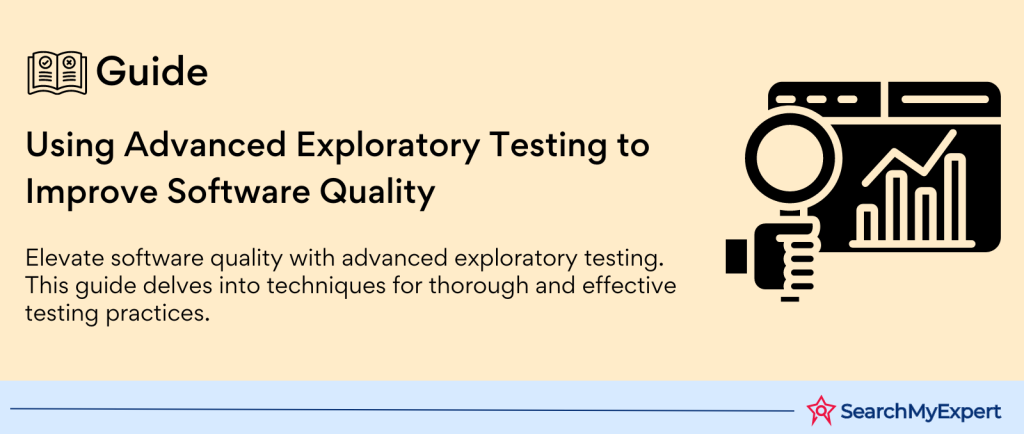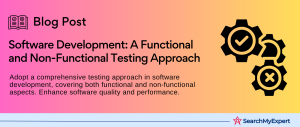Understanding Exploratory Testing
Exploratory testing stands as a dynamic and flexible approach to software testing, where testers are encouraged to apply their creativity, experience, and intuition to explore and test the software without the constraints of predefined test cases. This testing methodology emphasizes learning about the software as you test, adapting your approach as new insights emerge, and leveraging a more investigative process to uncover defects that may not be as easily detected through traditional scripted testing methods.
Key Principles and Characteristics
Exploratory testing is grounded in several key principles and characteristics that distinguish it from more structured testing approaches:
- Ad-hoc and Intuitive:
Testers have the freedom to explore the application without a set script, allowing them to pursue areas of interest or concern as they arise. - Continuous Learning:
As testers navigate through the software, they constantly gather new information, which informs subsequent testing efforts. - Adaptive Planning:
Test strategies and plans are developed on-the-fly, based on the tester’s understanding and insights gained during the testing process. - Simultaneous Design and Execution:
Test case design and execution happen concurrently, unlike in scripted testing where these activities are performed separately.
Benefits and Limitations Compared to Scripted Testing
Benefits
- Flexibility: Exploratory testing allows for rapid adaptation to new information and changing conditions within the software being tested.
- Efficiency: It can be more efficient in identifying certain types of issues, such as usability problems, that scripted tests might overlook.
- Creativity and Insight: This approach leverages the tester’s skills and creativity, potentially uncovering bugs that would not be detected by following a predetermined set of steps.
Limitations
- Documentation Challenges:
The dynamic nature of exploratory testing can result in less documentation, which may impact the reproducibility of tests and the sharing of findings. - Skill Dependency:
The effectiveness of exploratory testing heavily relies on the tester’s experience and intuition, which can lead to variability in test outcomes. - Coverage Uncertainty: Without predefined scripts, it can be challenging to ensure comprehensive coverage of the software’s functionality.
Different Types of Exploratory Testing
Exploratory testing can take various forms, each with its own focus and methodologies:
- Session-Based Testing:
This structured approach to exploratory testing involves timed testing sessions, specific objectives (charters), and debriefings to ensure accountability and coverage. - Charter-Based Testing:
Testers are guided by a charter, or mission statement, which outlines the goals and scope of a testing session but does not prescribe specific steps to follow. - Freestyle Exploratory Testing:
The least structured form, where testers have complete freedom to explore the application without any predetermined objectives or constraints.
Setting Up for Success in Exploratory Testing
Effective exploratory testing is not as unstructured and ad-hoc as it might initially seem. Proper preparation and a clear understanding of objectives, tools, criteria, and techniques are essential for maximizing the benefits of exploratory testing. This preparation ensures that the testing is focused, efficient, and aligned with the project’s goals.
Defining the Test Objective and Scope
The first step in setting up for successful exploratory testing is to define what you are testing for and the boundaries within which you are testing. This involves:
- Identifying the Test Objective:
Clarify what you intend to achieve with your testing. This could range from uncovering usability issues to verifying security vulnerabilities or performance issues. - Determining the Scope: Establish clear boundaries for your testing. This includes specifying the features or parts of the application to be tested and identifying any areas that should be excluded from testing.
Preparing the Testing Environment and Tools
A well-prepared testing environment and the right set of tools can significantly enhance the effectiveness of exploratory testing:
- Setting Up the Testing Environment:
Ensure that you have a stable and isolated testing environment that mimics the production environment as closely as possible to ensure accurate results. - Selecting Tools:
Choose tools that support exploratory testing efforts, such as bug-tracking systems, note-taking applications, and screen capture tools. These tools should facilitate easy documentation and reporting of findings.
Establishing Testing Criteria and Success Metrics
To measure the effectiveness of exploratory testing, it’s crucial to establish clear criteria and metrics for success:
- Defining Testing Criteria:
Outline what constitutes a successful test. This could include the number of critical bugs identified, coverage of key functionalities, or insights gained about the application’s usability. - Setting Success Metrics: Decide on the metrics that will be used to evaluate the success of the testing effort. These could be quantitative, such as the number of bugs found, or qualitative, such as the depth of understanding gained about the application.
Choosing Appropriate Exploratory Testing Techniques
Selecting the right techniques is essential for conducting effective exploratory testing. Depending on the test objective and scope, different approaches may be more suitable:
- Session-Based Testing:
Ideal for projects that require structured documentation and want to measure test coverage over time. - Charter-Based Testing:
Suitable for focused testing efforts, where specific aspects of the application need to be investigated. - Freestyle Exploratory Testing:
Best for highly experienced testers or when testing very early in the development cycle to get a broad understanding of the application’s state.
Exploring the System: A Deep Dive into Exploratory Testing
Once the groundwork for exploratory testing is laid out, the actual exploration of the system begins. This phase is where the tester’s creativity, intuition, and technical skills come into play, allowing for a dynamic and insightful exploration of the application. Effective exploration involves a blend of structured approaches like mind mapping and scenario building, along with the flexibility to follow one’s intuition and curiosity through the software.
Initiating the Testing Session: Mind Mapping and Scenario Building
Starting an exploratory testing session with a clear plan can significantly enhance its effectiveness:
- Mind Mapping: Create a visual representation of the application’s features, functionalities, and potential areas of risk. This map serves as a guide for exploration, helping testers identify and prioritize areas for testing.
- Scenario Building: Develop realistic user scenarios that can guide the testing process. These scenarios help testers step into the users’ shoes, exploring the system in ways that real users might interact with it.
Interactively Navigating the System, Following Intuition and Curiosity
The core of exploratory testing lies in the interactive and intuitive exploration of the system:
- Navigating Based on Curiosity:
Allow your curiosity to guide you through the system. If a feature or functionality piques your interest or seems like it might hide bugs, dive deeper. - Following Intuition:
Leverage your experience and intuition to explore areas that feel critical or vulnerable. Intuitive testing often leads to discovering complex bugs that scripted testing might miss.
Experimenting with Different Features and Functionalities
Exploratory testing is not just about using the application as intended but also about experimenting with it:
- Testing Beyond Expected Use:
Try using features in ways not covered by typical use cases. This could include inputting unexpected values, navigating the application in an unconventional order, or attempting to stress the system. - Exploring Edge Cases:
Focus on edge cases and boundary conditions, which are often overlooked in scripted testing but can reveal significant issues.
Documenting Findings and Observations Effectively
While exploratory testing is dynamic, documentation plays a crucial role in capturing findings and ensuring that insights are not lost:
- Note-Taking:
Keep detailed notes of your observations, including the steps taken, features tested, and any anomalies observed. Tools like digital note-taking applications can be invaluable here. - Use of Screenshots and Screen Recordings:
Visual documentation like screenshots and screen recordings can help illustrate issues clearly and provide a reference point for developers.
Identifying and Reporting Defects in Exploratory Testing
The identification and reporting of defects is a critical phase in exploratory testing, where the tester’s observations are transformed into actionable insights that can lead to meaningful improvements in the software. This process requires a keen eye for detail, analytical skills to assess the impact of defects, and clear communication to ensure that issues are understood and addressed effectively by the development team.
Recognizing Potential Issues and Defects During Exploration
As testers navigate and experiment with the system, recognizing potential issues and defects is paramount:
- Staying Alert: Always be on the lookout for anything that seems off, whether it’s a minor glitch in the UI or a major functionality failure.
- Understanding User Expectations:
Consider the end-user’s perspective to identify issues that could negatively affect the user experience, even if they’re not outright bugs.
Analyzing and Classifying the Severity and Impact of Defects
Once a potential defect is identified, it’s crucial to analyze and classify it based on its severity and impact:
- Severity Levels: Determine how serious the defect is, considering factors like whether it crashes the system, corrupts data, or merely causes a cosmetic issue.
- Impact Analysis: Assess the potential impact of the defect on the end-user and the business. Consider how frequently the issue is likely to occur and the extent of its effects on user satisfaction and business operations.
Reporting Findings Clearly and Concisely
Effective defect reporting is essential for ensuring that identified issues are addressed promptly and accurately:
- Clear and Concise Descriptions:
Provide a straightforward and detailed description of the issue, avoiding technical jargon that might confuse non-technical team members. - Steps to Reproduce:
Include detailed steps that lead to the defect, ensuring that developers can replicate the issue on their end. - Supporting Evidence:
Attach screenshots, screen recordings, or logs that can help illustrate the problem and provide context to the developers.
Collaborating with Developers for Effective Defect Resolution
The final step in the defect reporting process involves collaboration with the development team:
- Open Communication: Maintain open lines of communication with developers, encouraging questions and discussions about the reported issues.
- Prioritization and Planning:
Work with the team to prioritize defects based on their severity and impact, and plan for their resolution in a way that aligns with the project’s goals and timelines. - Follow-up: Stay engaged in the resolution process, offering additional information or clarification as needed, and verify that the issue has been resolved once a fix has been implemented.
Learning and Adapting from Exploratory Testing Sessions
The exploratory testing process doesn’t end with the identification and reporting of defects. A crucial component of maximizing the value of exploratory testing lies in the reflection, learning, and adaptation that follow each testing session. This continuous improvement cycle not only enhances the effectiveness of future testing efforts but also contributes to the personal growth of testers and the overall quality of the software.
Reflecting on the Testing Session and Identifying Areas for Improvement
After each exploratory testing session, take the time to reflect on the process and outcomes:
- Review Your Approach:
Analyze the strategies and techniques used during the session. Consider what worked well and what could be improved. - Evaluate Coverage and Effectiveness: Reflect on the areas of the system that were tested and the defects that were found. Identify any gaps in testing coverage or areas that might need more attention in future sessions.
Learning from Encountered Bugs and Adapting Testing Strategies
Each defect uncovered during exploratory testing offers an opportunity to learn and adapt:
- Analyze Defect Patterns: Look for patterns in the bugs identified. This can provide insights into potential weaknesses in the software or in the testing approach.
- Adapt Testing Strategies:
Use the insights gained from analyzing defects to refine your testing strategies. This might involve placing a greater focus on certain types of functionality or incorporating new testing techniques.
Sharing Learnings and Best Practices with Other Testers
Exploratory testing thrives on the collective knowledge and experience of the testing community:
- Document Best Practices: Compile the effective strategies, techniques, and lessons learned into best practice guides or checklists that can be shared with others.
- Participate in Knowledge Sharing:
Engage in discussions with other testers, whether through formal meetings, informal chats, or community forums. Sharing experiences and insights can help elevate the testing practices of the entire team or community.
Continuously Refining Your Exploratory Testing Skills
The field of software testing is ever-evolving, and so should the skills of an exploratory tester:
- Seek Out Learning Opportunities:
Stay abreast of the latest testing methodologies, tools, and technologies. Participate in training sessions, workshops, and conferences. - Practice Reflective Learning:
Regularly set aside time to reflect on your testing experiences, challenges faced, and how they were overcome. This reflective practice can be instrumental in identifying areas for personal and professional development.
Integrating Exploratory Testing with Other Testing Techniques
Integrating exploratory testing with other testing methodologies can significantly enhance the overall quality assurance strategy of a software development project. While exploratory testing offers flexibility and the ability to uncover unexpected issues, combining it with more structured testing approaches ensures comprehensive coverage and a robust testing process. This integration not only leverages the strengths of each method but also fosters collaboration and knowledge sharing among different testing teams.
Combining Exploratory Testing with Scripted Testing for Comprehensive Coverage
Scripted testing, with its predefined test cases and steps, provides a systematic approach to testing, ensuring that all specified requirements are verified. Integrating exploratory testing with scripted testing allows teams to enjoy the best of both worlds:
- Pre and Post-Scripted Testing Exploration: Use exploratory testing before scripted testing to identify any potential issues that might have been overlooked in the test plan. After scripted testing, exploratory testing can uncover additional issues that were not covered by the test cases.
- Iterative Enhancement of Test Scripts: Insights gained from exploratory testing can be used to refine and expand the test scripts, making them more effective in future testing cycles.
Using Exploratory Testing to Complement Other Testing Approaches
Exploratory testing can complement various other testing methodologies, enhancing their effectiveness and coverage:
- Usability Testing:
Exploratory testing can add depth to usability testing by allowing testers to simulate real-world user behaviors and scenarios that may not be covered by structured usability tests. - Performance and Security Testing:
While these areas often rely on specific tools and scripts, exploratory testing can help identify issues that automated tools might miss, such as unexpected user actions that could impact performance or security.
Ensuring Integration and Collaboration with Different Testing Teams
Effective integration of exploratory testing with other testing techniques requires collaboration and communication among different testing teams:
- Cross-Functional Teams: Encourage teams to work together in cross-functional groups, where members from different testing disciplines share knowledge and perspectives. This can lead to a more holistic understanding of the application and its potential vulnerabilities.
- Shared Documentation and Tools:
Use common platforms for documenting test cases, bugs, and insights. This ensures that all relevant information is accessible to everyone involved in the testing process, facilitating better integration of different testing methodologies. - Regular Sync-Up Meetings:
Hold regular meetings to discuss findings, share insights, and plan combined testing strategies. This helps align the goals and efforts of different teams, ensuring that exploratory testing and other testing methods complement each other effectively.
Advanced Exploratory Testing Practices
Exploratory testing is a hands-on, approach driven by the tester’s intuition, experience, and understanding of the system, rather than predefined test cases. It emphasizes the personal freedom and responsibility of the individual tester to continually optimize the quality of his or her work by treating test-related learning, test design, and test execution as mutually supportive activities that run in parallel throughout the project. Here’s a deeper look into advanced exploratory testing practices including pair testing, context-driven testing, mobile exploratory testing, leveraging automation, scaling for larger projects, and measuring effectiveness.
Utilizing Advanced Techniques
Pair Testing
Pair testing involves two team members (often a tester and another role like a developer or another tester) working together on the same test session. This technique harnesses diverse perspectives, promoting knowledge sharing and more thorough exploration of the application. It’s particularly effective in complex areas where one individual might not catch all potential issues. The dynamic interaction often leads to uncovering unique bugs and generating innovative test ideas.
Context-Driven Testing
Context-driven testing adapts the testing approach based on the context of the project. It recognizes that each project is unique, and therefore, the testing approach must be tailored to fit the specific circumstances. This means considering factors like the project’s goals, risks, team skills, and available resources to design an effective testing strategy. Context-driven testing is flexible and responsive, allowing testers to adjust their approach as the project evolves and new information becomes available.
Mobile Exploratory Testing
With the proliferation of mobile devices, mobile exploratory testing has become crucial. It involves testing mobile apps in real-world scenarios, considering factors like varying network conditions, interruptions (calls, notifications), and device-specific features. Testers use their devices to explore different functionalities, often without predefined scripts, to find issues that may not be apparent in a more controlled testing environment.
Leveraging Automation Tools
Automation tools can significantly enhance the efficiency of exploratory testing. While exploratory testing is inherently manual, automation can support it in several ways:
- Automated Test Setup:
Quickly setting up test environments or data. - Automated Checks:
Running automated checks to cover regression scenarios, freeing testers to focus on new and complex features. - Tools for Capturing Test Sessions:
Tools that automatically capture actions, screenshots, and logs during test sessions, making it easier to reproduce and report issues.
Scaling Exploratory Testing for Large Projects
Scaling exploratory testing in large projects or complex systems involves strategic planning:
- Distributed Testing Teams:
Utilize distributed testing teams, encouraging diverse perspectives and coverage across different time zones. - Session-Based Test Management (SBTM): Implement SBTM to structure exploratory testing efforts, defining objectives for test sessions and tracking outcomes.
- Charter Creation:
Develop clear charters that guide testers on the focus areas without restricting their exploratory nature.
Measuring the Effectiveness of Exploratory Testing Practices
Measuring the effectiveness of exploratory testing can be challenging due to its qualitative nature. However, some metrics and indicators can help:
- Bug Discovery Rate:
The number and severity of issues found during exploratory testing sessions. - Test Coverage:
Assessment of features or areas covered during testing sessions, often documented through session sheets or tools. - Feedback from Stakeholders:
Qualitative feedback from developers, project managers, and customers on the value added by the exploratory testing efforts. - Learning and Adaptation:
How findings from exploratory testing lead to improvements in the product and testing process.
Conclusion:
Exploratory testing stands as a pivotal component in the realm of software testing, offering a dynamic approach that adapts to the complexities and unique challenges of modern software projects. By integrating advanced practices such as pair testing, context-driven testing, and mobile exploratory testing, teams can harness the full potential of exploratory testing to uncover hidden issues, ensure comprehensive coverage, and enhance product quality. Leveraging automation tools within exploratory testing processes not only boosts efficiency but also allows testers to focus on more critical, high-value areas of the application.
Bring precision to your software development with our Software Testing Service.
Table of Contents
Toggle






